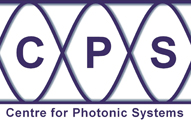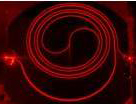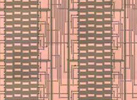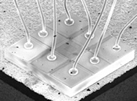| Centre for Photonic Systems Engineering Department Electrical Engineering Division |
 |
 |
 |
 |
 |
| Home | Research | People | Publications | Teaching | CDT | News | Contact |
|---|
|
CURRENT PROJECTS
PREVIOUS PROJECTS |
Channel Optimised Distributed Passive Sensor Networks The Internet of Things recognises the value of interconnecting vast numbers of physical objects equipped with sensors to enable process automation and new data applications. For a wide range of applications the sensors will be wireless and operate without a battery or internal power supply, reducing the cost and complexity of the sensor. Radiative radio frequency (RF) energy transfer is an attractive method to provide small amounts power to electronic devices over a range of a few meters and is already used in radio frequency identification (RFID) systems which are increasingly replacing barcodes. However, the power available at the sensor or tag is severely limited which has limited the range of sensor tags so far preventing effective wide area operation. This project seeks to address the limited range of passive wireless sensor tags, by considering for the first time a complete sensor network comprised of multiple sensors and a unified distributed interrogator network. Most RF power delivery systems are limited by reflections which occur in realistic environments. Here use of multiple antennas will allow the wireless channel (reflections) to be characterised and the transmitted signals optimised to mitigate the effects, increasing the RF power available at the sensor tag when it is required to collect a data sample, improving the performance of both digital and analog sensor tags. This will enable both more energy intensive sensor functions and wider operating areas with greater reliability opening up a range of applications where the performance of passive sensor tags has currently insufficient. With a wider operating area, a new problem of large populations of sensor tags simultaneously operating in the interrogation region will also be addressed. An application model will consider which sensors are required to operate with what duty cycle to ensure sufficient data is collected. This can be optimised by considering the mutual information of multiple sensors and also the channel information to select those sensors with the most favourable channels. Finally, the developed sensor tags and interrogator system will be built into a demonstrator for healthcare applications. This will both guide the development of the application model to cope with multiple different sensors with different power and duty cycle requirements, and also allow the system to be demonstrated to potential future collaborators (both academic and industrial) across various disciplines. We believe the potential impact in healthcare is significant due to the less intrusive nature of wireless sensing, less bulky sensors with no battery and the ability of sensors to be readily disposable at low cost. The project is led by the group and partnered with ARM Ltd and PervasID Ltd. For further information please visit: https://gtr.ukri.org/projects?ref=EP%2FS019405%2F1 |
2020 Centre for Photonic Systems: information provided by webmaster@cps.cam.ac.uk |